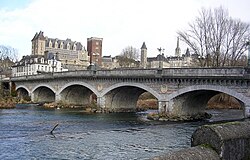Pyrénées-Atlantiques
Pyrénées-Atlantiques (Gascon: Pirenèus-Atlantics; Basque: [Pirinio-Atlantiarrak] Error: {{Lang}}: text has italic markup (help) or Pirinio-Atlantikoak) is a department in the Nouvelle-Aquitaine region of France. It takes its name from the Pyrenees mountains and the Atlantic Ocean.
 | |
 Location of Pyrénées-Atlantiques in France | |
| Coordinates: 43°15′N 0°50′E / 43.250°N 0.833°ECoordinates: 43°15′N 0°50′E / 43.250°N 0.833°E | |
| Country | France |
| Region | Nouvelle-Aquitaine |
| Département | 4 March 1790 |
| Prefecture | Pau |
| Subprefectures | Bayonne, Oloron-Sainte-Marie |
| Government | |
| • President | Jean-Jacques Lasserre |
| Area | |
| • Total | 7,644.8 km2 (2,951.7 sq mi) |
| Population (2014)[3] | |
| • Total | 667,249 |
| • Density | 87.2814/km2 (226.0578/sq mi) |
| Time zone | UTC+1 (CET) |
| • Summer (DST) | UTC+2 (CEST) |
| ISO 3166 code | FR-64 |
| Arrondissements | 3 |
| Cantons | 27 |
| Communes | 546 |
| Website | http://www.le64.fr |
History
Pyrénées-Atlantiques is one of the 83 French departments made during the French revolution, on 4 March 1790, with the name of Basses-Pyrénées. It was created from parts of the old provinces of Guyenne, Béarn, and Gascony.
The new department had six districts: Mauléon, Oloron, Orthez, Pau, Saint- Palais and Ustaritz.
The first prefecture was Navarrenx but then it was moved to Pau; in 1795, the prefecture was moved to Saint-Palais but in 1796 it was returned to Pau.[4]
On 10 October 1969, the name of the department was changed from Basses-Pyrénées to Pyrénées-Atlantiques.[4]
Geography
Pyrénées-Atlantiques is part of the Nouvelle-Aquitaine region, southwestern France, and is the 10th French department in area with 7,644.8 km2 (2,952 sq mi).[2]
There are two small territorial enclaves—a remnant from the Middle Ages— that are part of the neighboring Hautes-Pyrénées department.
The department is surrounded by the departments:
- Landes and Gers to the north,
- Hautes-Pyrénées to the east,
and by Spain to the south and the Bay of Biscay (Atlantic Ocean) to the west.
The Pyrenees mountain range is found in the southern part of the department and goes, east to west, from the Col d'Aubisque, a mountain pass 30 km (19 mi) south of Tarbes and Pau, to the mouth of the river Bidasoa.
The Pic Palas (42°50′58″N 0°18′48″E / 42.84944°N 0.31333°E), at 2,974 m (9,757 ft), is the highest point of the department and also the highest of the Aquitaine region; it is on the border with Spain.[5]
The main river of the department is the Adour and all rivers in the department, except for some coastal small rivers, flow into this river. Other important rivers are the Gaves réunis, formed by the rivers Gave d'Oloron and Gave de Pau, and the Nive.
Climate
The climate of Pau is Marine West Coast Climate (Köppen climate classification Cfb), with mild winters and warm summers.[6]
The average temperature for the year in Pau is 13.5 °C (56.3 °F). The warmest month, on average, is July with an average temperature of 20.7 °C (69.3 °F). The coolest month on average is January, with an average temperature of 6.6 °C (43.9 °F).
The average amount of precipitation for the year in Pau is 1,051.6 mm (41.4 in). The month with the most precipitation on average is December with 104.1 mm (4.1 in) of precipitation. The month with the least precipitation on average is February with an average of 73.7 mm (2.9 in).[6]
| Climate data for Uzein (Pau), Pyrénées-Atlantiques, France | |||||||||||||
|---|---|---|---|---|---|---|---|---|---|---|---|---|---|
| Month | Jan | Feb | Mar | Apr | May | Jun | Jul | Aug | Sep | Oct | Nov | Dec | Year |
| Daily mean °C (°F) | 6.6 (43.9) |
7.4 (45.3) |
10.0 (50) |
11.9 (53.4) |
15.6 (60.1) |
18.7 (65.7) |
20.7 (69.3) |
20.7 (69.3) |
18.2 (64.8) |
14.7 (58.5) |
9.8 (49.6) |
7.2 (45) |
13.46 (56.23) |
| Rainfall mm (inches) | 84.9 (3.343) |
74.7 (2.941) |
79.2 (3.118) |
73.1 (2.878) |
97.9 (3.854) |
88.3 (3.476) |
86.6 (3.409) |
79.1 (3.114) |
89 (3.5) |
100.4 (3.953) |
94.2 (3.709) |
103.8 (4.087) |
1,051.2 (41.386) |
| Source: Weatherbase.com [1] | |||||||||||||
Administration
The department is managed by the Departamental Council of the Pyrénées-Atlantiques in Pau. Pyrénées-Atlantiques is part of the region of Nouvelle-Aquitaine.
Administrative divisions
There are 3 arrondissements (districts), 27 cantons and 546 communes (municipalities) in the Pyrénées-Atlantiques.[7]
| INSEE Code |
Arrondissement | Capital | Population[8] (2014) |
Area[9] (km²) |
Density (Inh./km²) |
Communes |
|---|---|---|---|---|---|---|
| 641 | Bayonne | Bayonne | 287,546 | 2,269.9 | 126.7 | 122 |
| 642 | Oloron-Sainte-Marie | Oloron-Sainte-Marie | 74,614 | 2,884.9 | 25.9 | 155 |
| 643 | Pau | Pau | 305,089 | 2,490.0 | 122.5 | 269 |
The following is a list of the 27 cantons of the Pyrénées-Atlantiques department, following the French canton reorganisation which came into effect in March 2015:[10]
- Anglet (6401)
- Artix et Pays de Soubestre (6402)
- Baïgura et Mondarrain (6403)
- Bayonne-1 (6404)
- Bayonne-2 (6405)
- Bayonne-3 (6406)
- Biarritz (6407)
- Billère et Coteaux de Jurançon (6408)
- Le Cœur de Béarn (6409)
- Hendaye-Côte Basque-Sud (6410)
- Lescar, Gave et Terres du Pont-Long (6411)
- Montagne Basque (6412)
- Nive-Adour (6413)
- Oloron-Sainte-Marie-1 (6414)
- Oloron-Sainte-Marie-2 (6415)
- Orthez et Terres des Gaves et du Sel (6416)
- Ouzom, Gave et Rives du Neez (6417)
- Pau-1 (6418)
- Pau-2 (6419)
- Pau-3 (6420)
- Pau-4 (6421)
- Pays de Bidache, Amikuze et Ostibarre (6422)
- Pays de Morlaàs et du Montanérès (6423)
- Saint-Jean-de-Luz (6424)
- Terres des Luys et Coteaux du Vic-Bilh (6425)
- Ustaritz-Vallées de Nive et Nivelle (6426)
- Vallées de l'Ousse et du Lagoin (6427)
Demographics
The inhabitants of Pyrénées-Atlantiques are known, in French, as Basques et Béarnais (women: Basques et Béarnaises).[11] The Basques live mainly in the western part of the department and the Béarnais in the eastern part. From 1790 to 1969, before the change of the name of the department, the inhabitants of this departmente were known as Bas-Pyrénéens.
The Pyrénées-Atlantiques has a population, in 2014, of 667,249,[3] for a population density of 87.3 inhabitants/km2. The arrondissement of Pau, with 305,089 inhabitants, is by far the largest. The other two, Bayonne and Oloron-Sainte-Marie, have respectively 287,546 and 74,614 inhabitants.[8]
Evolution of the population in Pyrénées-Atlantiques

The city with more people living in it is the capital, Pau, with 77,489 inhabitants, the 11.6% of the total population of the department. The subprefectures of Bayonne and Oloron-Sainte-Marie have, respectively, 48,178 inhabitants (7.2%) and 10,824 inhabitants (1.6%).[8]
The main cities in the department are:

| City | Population[8] (2014) |
Arrondissement |
|---|---|---|
| Pau | 77,489 | Pau |
| Bayonne (Basque: [Baiona] Error: {{Lang}}: text has italic markup (help)) | 48,178 | Bayonne |
| Anglet (Basque: [Angelu] Error: {{Lang}}: text has italic markup (help)) | 38,633 | Bayonne |
| Biarritz (Basque: [Miarritze] Error: {{Lang}}: text has italic markup (help)) | 24,713 | Bayonne |
| Hendaye (Basque: [Hendaia] Error: {{Lang}}: text has italic markup (help)) | 16,783 | Bayonne |
| Saint-Jean-de-Luz (Basque: [Donibane Lohitzun] Error: {{Lang}}: text has italic markup (help)) |
13,431 | Bayonne |
| Billère | 13,336 | Pau |
| Lons | 12,616 | Pau |
| Oloron-Sainte-Marie | 10,824 | Oloron-Sainte-Marie |
| Orthez | 10,722 | Pau |
Gallery
Villa Belza in Biarritz
Pyrénées-Atlantiques Media
French Basque Country (western side) and the Béarn (eastern side)
The Boulevard des Pyrénées in the town of Pau
The port of Saint-Jean-de-Luz
Related pages
References
- ↑ "Le président, Jean-Jacques Lasserre" (in French). Les Pyrénées-Atlantiques. Archived from the original on 24 November 2016. Retrieved 5 November 2016.
{{cite web}}: CS1 maint: unrecognized language (link) - ↑ 2.0 2.1 "Département des Pyrénées-Atlantiques (64) - Résumé statistique". Publications et statistiques pour la France ou les régions (in French). Institut national de la statistique et des études économiques - INSEE. Retrieved 5 November 2016.
{{cite web}}: CS1 maint: unrecognized language (link) - ↑ 3.0 3.1 "Populations légales 2014: Recensement de la population - Régions, départements, arrondissements, cantons et communes" (in French). Institut national de la statistique et des études économiques - INSEE. Retrieved 22 April 2017.
{{cite web}}: CS1 maint: unrecognized language (link) - ↑ 4.0 4.1 "Historique des Pyrénées-Atlantiques". Le SPLAF (in French). Retrieved 25 March 2014.
{{cite web}}: CS1 maint: unrecognized language (link) - ↑ "Pic Palas, France/Spain". Peakbagger.com. Retrieved 27 March 2014.
- ↑ 6.0 6.1 "Uzein, France - Köppen Climate Classification". Weatherbase. Retrieved 28 March 2014.
- ↑ "Département des Pyrénées-Atlantiques (64)". Géographie administrative et d'étude (in French). Institut national de la statistique et des études économiques - INSEE. Retrieved 22 April 2017.
{{cite web}}: CS1 maint: unrecognized language (link) - ↑ 8.0 8.1 8.2 8.3 "Régions, départements, arrondissements, cantons et communes" (PDF). Populations légales 2014 (in French). Institut national de la statistique et des études économiques - INSEE. Retrieved 22 April 2017.
{{cite web}}: CS1 maint: unrecognized language (link) - ↑ "Département des Pyrénées-Atlantiques (64)". Comparateur de territoire (in French). Institut national de la statistique et des études économiques - INSEE. Retrieved 22 April 2017.
{{cite web}}: CS1 maint: unrecognized language (link) - ↑ "Décret n° 2014-248 du 25 février 2014 portant délimitation des cantons dans le département des Pyrénées-Atlantiques" (in French). Légifrance.gouv.fr. Retrieved 6 November 2016.
{{cite web}}: CS1 maint: unrecognized language (link) - ↑ "Pyrénées-Atlantiques (64)" (in French). habitants.fr. Retrieved 26 March 2014.
{{cite web}}: CS1 maint: unrecognized language (link)
Other websites
| Wikimedia Commons has media related to Lua error in Module:Commons_link at line 62: attempt to index field 'wikibase' (a nil value).. |
- General Council of Pyrénées-Atlantiques Archived 1998-12-01 at the Wayback Machine (in French)
- Prefecture official website (in French)













